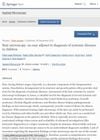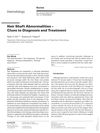New Clinico-Genetic Classification of Trichothiodystrophy
August 2009
in “
American Journal of Medical Genetics Part A
”
TLDR A new classification for trichothiodystrophy helps identify genetic causes and potential treatments.
The study reviewed 122 patients with trichothiodystrophy (TTD) to establish a new clinico-genetic classification based on genotype-phenotype correlations. It distinguished between patients with DNA repair anomalies (group A) and those without (group B), identifying DNA repair deficiencies in 42 patients with mutations in genes like XPD, XPB, and p8, while 37 patients had normal DNA repair, with 28 having TTDN1 mutations. The research highlighted the genetic heterogeneity of TTD and proposed a classification into three genetic groups based on DNA repair status and TTDN1 mutations. The study emphasized the variability in TTD manifestations and the importance of genetic analysis in diagnosis, noting that despite DNA repair defects, TTD patients were not cancer-prone, unlike those with xeroderma pigmentosum.



